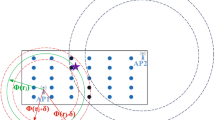Abstract
In recent years, indoor localization base on fingerprint has become more and more common. In many fingerprint-based indoor positioning algorithms, it’s very popular to use WiFi signal characteristics to represent the location fingerprint. However, with the great improvement of IEEE 802.11 protocols, WiFi has been broadly used. So there are numbers of WiFi access points (APs) have been deployed everywhere which can be used for localization purpose. The large amount of AP can greatly increase the dimension of the fingerprint and localization complexity. In this paper, we propose a novel indoor positioning algorithm MTAPS (indoor localization algorithm based on multiple times access point selection). MTAPS can effectively reduce the complexity of localization computation, and improve the performance of localization with an efficient access point selection algorithm. This indoor localization algorithm can get a better subset of APs through multiple times AP selection method. These selected APs will be more stable and can provide a better discriminative capability to reference locations. In addition, MTAPS uses k-means algorithm to cluster reference locations, and makes up a decision tree for every location cluster. After location clustering, MTAPS re-selects a suitable AP subset for every cluster. This method can further improve localization performance. Experimental results show that MTAPS has better localization performance than the indoor localization algorithm which is based on classical AP selection algorithm. And MTAPS can achieve the accuracy of over 90% within 2 m localization error.
Supported by the program of Key Industry Innovation Chain of Shaanxi Province, China (2017ZDCXL-GY-04-02), of the program of Xi’an Science and Technology Plan (201805029YD7CG13(5)), Shaanxi, China, of Key R&D Program – The Industry Project of Shaanxi (Grant No. 2018GY-017), of Key R&D Program – The Industry Project of Shaanxi (Grant No. 2017GY-191) and of Education Department of Shaanxi Province Natural Science Foundation, China (15JK1742).
Access this chapter
Tax calculation will be finalised at checkout
Purchases are for personal use only
Similar content being viewed by others
References
Kaemarungsi, K., Krishnamurthy, P.: Modeling of indoor positioning systems based on location fingerprinting. IEEE INFOCOM 2, 1012–1022 (2004)
Youssef, M.A., Agrawala, A., Shankar, A.U.: WLAN location determination via clustering and probability distributions. In: IEEE International Conference on Pervasive Computing and Communications, pp. 143–150 (2003)
Du, L., Bai, Y., Chen, L.: Access point selection strategy for large-scale wireless local area networks. In: IEEE Wireless Communications and Networking Conference, pp. 2161–2166 (2007)
Chen, Y., Yang, Q., Yin, J., et al.: Power-efficient access-point selection for indoor location estimation. IEEE Trans. Knowl. Data Eng. 18(7), 877–888 (2006)
Zhao, Q., et al.: An effective preprocessing scheme for WLAN-based fingerprint positioning systems. In: IEEE International Conference on Communication Technology, pp. 592–595 (2010)
Kushki, A., Plataniotis, K.N., Venetsanopoulos, A.N.: Kernel-based positioning in wireless local area networks. IEEE Trans. Mob. Comput. 6(6), 689–705 (2007)
Zou, G., et al.: An indoor positioning algorithm using joint information entropy based on WLAN fingerprint. In: IEEE International Conference on Computing, pp. 1–6 (2014)
Laoudias, C., Panayiotou, C.G., Kemppi, P.: On the RBF-based positioning using WLAN signal strength fingerprints. In: 7th Workshop on Positioning, Navigation and Communication, Dresden, pp. 93–98 (2010)
Duda, R.O., Hart, P.E., Stork, D.G.: Pattern Classification. Wiley, Hoboken (2012)
Quinlan, J.R.: C4.5: Programs for Machine Learning. Elsevier, Amsterdam (2014)
Author information
Authors and Affiliations
Corresponding author
Editor information
Editors and Affiliations
Rights and permissions
Copyright information
© 2019 ICST Institute for Computer Sciences, Social Informatics and Telecommunications Engineering
About this paper
Cite this paper
Huang, P., Zhao, H., Liu, W., Jiang, D. (2019). MTAPS: Indoor Localization Algorithm Based on Multiple Times AP. In: Song, H., Jiang, D. (eds) Simulation Tools and Techniques. SIMUtools 2019. Lecture Notes of the Institute for Computer Sciences, Social Informatics and Telecommunications Engineering, vol 295. Springer, Cham. https://doi.org/10.1007/978-3-030-32216-8_2
Download citation
DOI: https://doi.org/10.1007/978-3-030-32216-8_2
Published:
Publisher Name: Springer, Cham
Print ISBN: 978-3-030-32215-1
Online ISBN: 978-3-030-32216-8
eBook Packages: Computer ScienceComputer Science (R0)




